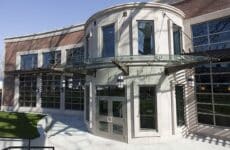By: Kimberly Osborne
Posted In: News

Photo credit: Kimberly Osborne
This is the spot where New Breakers used to be.

Photo credit: Salve Today
The New Breakers Apartments shortly after the fire. The fire destroyed the building, causing the need for it to be torn down for safety reasons,

Photo credit: Salve Today
New Breakers before the fire.
It’s been a month since fire destroyed the New Breakers Apartments and the memories are still vivid for members of the Salve community. University officials continue to probe the subject and are taking advantage of the opportunity to learn from the experience and further educate its students on fire safety and other issues surrounding it.
With the effects of the fire still surfacing for those who lived in New Breakers, some students may be considering what it would have been like for them had the fire occurred in their dorms instead of the New Breakers Apartments. Students might wonder about what would become of all of their personal property in a similar situation or any situation that left their personal property damaged or missing. According to Michael Grandchamp, the controller of the business office, the policies concerned with personal property insurance are outlined in both the student handbook and in the housing contract, but in light of the tragedy Grandchamp thinks it is important to really educate the community about these policies and simply know where they stand if anything at all happens to their property. Grandchamp points out that all students are allowed to bring what they please to campus in order to personalize their living space; the personal property that a student brings is then the responsibility of the student. The University cannot insure your personal property because there must be what insurance companies call an “insurable interest”. Only you or your parents possess this “insurable interest”. When going away to school there are a few insurance options. The first is homeowner’s insurance. If a student’s family owns a home then the personal property that a student brings with them to school is covered under that plan. If a student’s family rents, they may purchase renter’s insurance. Lastly you can purchase supplemental personal property insurance through residential life office. It is called the Student Personal Property plan and is offered through National Student Services Inc. The form for this insurance is sent out before the start of Fall semester every year. The standard plan offering is for $5000 worth of coverage with a $100 deductible. This plan can be obtained for $111 per year. Depending on what a student brings away to school, one can purchase more or less of this type of insurance. This Insurance covers stolen property, property damaged in either an accident or in a situation such as a fire or a water main break. Grandchamp also encourages those living off campus to obtain renter’s insurance or this supplemental personal property insurance and be aware of your belongings no matter where you live. “That’s why it is important to think about the property you bring relative to where you live, what type of insurance coverage you have and how much responsibility to you want to assume,” said Grandchamp. In, light of the fire, Grandchamp said that the university is taking steps to help students and their families understand the insurance issues as best they can in the future. The policies will be made more visible on the housing contract than they were before and there will be a check box in place to make certain that student’s understand that they are responsible for their personal property and that there is insurance available if they want it. Grandchamp said that there will also be a more enhanced disclosure of these policies in the student handbook. Grandchamp also plans to incorporate a section about insurance into a presentation that he gives during freshman orientation. According to Grandchamp the university is doing all they can to help the victims of the fire and to help educate the entire community. Grandchamp said that officials are constantly meeting about the issues surrounding the fire and that the matter is certainly not a forgotten one. One official who has continued to attend meetings about the fire is John Mixter, the director of safety and security at Salve. According to Mixter, the fire that destroyed New Breakers started on one of the walls in the garage of the building and was electrical, but other than that it is unclear what exactly triggered the blaze. Mixter said that the fire marshal told him that there may never be an answer to that question and that there was nothing that anyone could have done to avoid it, it was simply an accident. According to Mixter, the fire was not caused by a student’s actions, a faulty system, nor is it a case of negligence. Mixter said that Salve has abided by all of the safety regulations and was up to date on all of the fire codes. Each of the buildings on campus undergoes quarterly tests done by an outside contractor, all are documented in the safety and security offices; the last test took place in Feb. Mixter pointed out that the state of Rhode Island has really enhanced its fire codes since The Station Fire in Warwick and now have some of the strictest in the country, all of which Salve has obeyed. Mixter encourages students who have questions about the fire and any issues surrounding it to go to the safety and security officials or any other officials on campus and ask those questions. Mixter said that he is very proud of how the students handled themselves during the fire and feels that Salve does an excellent job of education its students on safety. “I think that there is no question that Salve cares about its students and about fire safety,” said Mixter. Kristine Hendrickson,director of communications also believes that Salve takes fire safety very seriously and has had proof of that the university’s achievements in that category. Hendrickson said that she has received emails from parents who are involved in fire service commending the school on its outstanding commitment to educating the Salve community on fire safety. “For a school of this size, Salve is really ahead of the game,” said Hendrickson. Having used to work for Fire engineering Magazine, Hendrickson has seen her share of terrible fires, but was struck by one that she saw on video while preparing a promotional piece. Hendrickson said that she was in awe of the flames brought about because of a towel that was left too close to a space heater. Hendrickson said that during her time with the magazine she realized that many fires are caused by carelessness, either by lit cigarettes or candles, but that was not the case with New Breakers. Hendrickson said that what she hopes that what the community takes away from this experience is the understanding of having to be prepared on two levels: be cautious and if the fire is out of your control, know your evacuation route. Having said this, Hendrickson stressed that one can never be too prepared in any emergency and despite how many times you have gone over procedure that one can never be sure of how they will react in the face of danger. “Every fire and every other emergency situation, no matter how much you prepare for it, is different,” said Hendrickson. “It is important for people to understand that and be willing to adapt in any given situation.”













